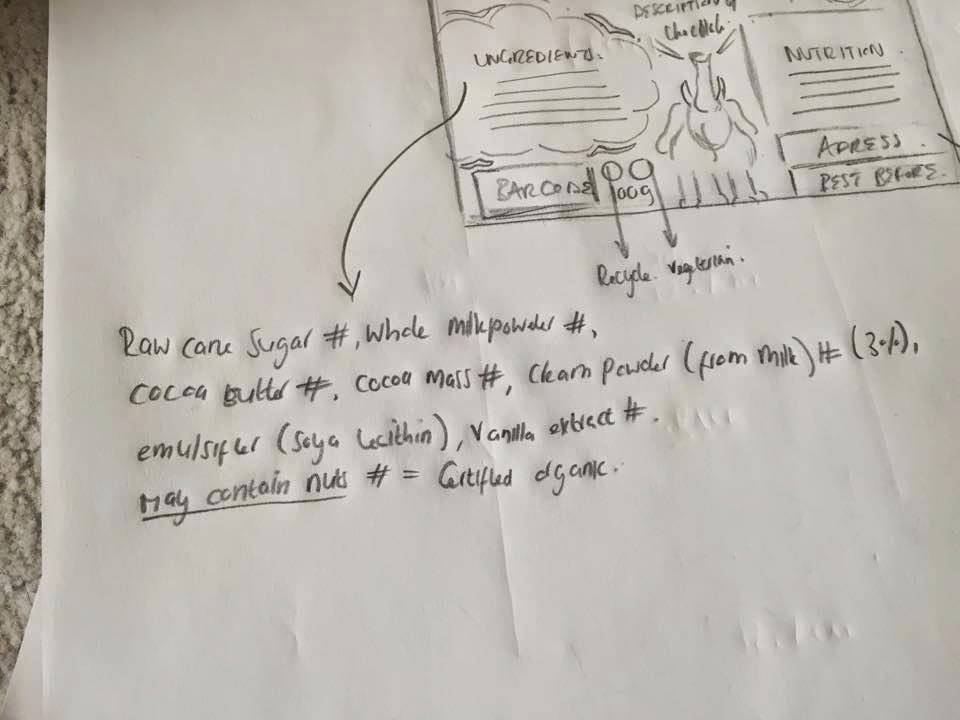OUGD601.
PRACTICAL ELEMENT.
DIGITAL DEVELOPMENT.
Today I worked on digitalising both the front and back design of the belly band sleeve packaging.
I started with the design of the front of the packaging, I followed my plans of trying to make the chocolate appear 3d, as if it has been debossed and moulded. I had planned to do this in sketch up or if necessary transporting the image into cinema 4d, however I attempted to do so in illustrator first. I also implemeneted the idea of doing the constellations and beams of light in gold foil. I felt that this would create a more attractive aesthetic and therefore be more eye catching.
I also experimented with different colour, as I was afraid that the design would in fact look too brown. However I felt the pallet of brown was more organic and natural.
In order to start seeing how the aesthetic of the whole packaging would work together, I started looking at producing the back cover of the packaging so I could then work between both, editing to adjust to fit the other.
I followed the guide I had originally created in my sketch, representing the foiled sections with a gold colour.
I also created a unique barcode for the chocolate bar to add another essence of beauty and uniqueness to the chocolate bar.
I wanted to make sure that although the chocolate bar is not automatically recognised as a sustainable/ green product, that After the first impression of being sold by the packaging, consumers are able to discover clearly, with a bright green logo that the chocolate is certified sustainable palm oil, however this comes after the initial attraction to the packaging via the front and the product.
I again experimented with alternate colours as I felt that this would work great in contrasting with the gold foil I planned on adding, I wasn't particularly sold on the blue, however felt that a dark colour would work better in contrast to the centre title piece and foil.
I had originally planned to include a reference to the sustainable story I am designing for the wrapper, by including an illustration of an elephant. However when working to make the layout of the back of the packaging simple and clear I found that the illustration hindered this, and so I removed it from the design.
I then started going back and fourth between the front and back of the packaging adding to and adjusting the design.
I also altered the colour pallet to change the background to a darker colour in order to increase contrast and the striking effect of the logo against the background and foil elements.
Happy with the layout and design so far, I went into cinema 4d with the logo and experimented to try and come up with a more realistic representation of chocolate mould text / design.
(I've lost my screenshots for this when I cleared my desktop to make space for more work)
Firstly I took the illustrator file and separated it into different files; the back of the bar, the gold parts, and the text. I mirrored the files horizontally and exported them as an illustrator 8 file (to be compatible with C4D) Once I imported all the illustrator files, I applied an extrude objects setting to the illustrator files. I then extruded the faces to different depths so that the chocolate bar could take its three dimensional shape.
I also applied a fillet cap to the faces, this rounded the edges where the illustrator lines where to give the bar a smoother shape. In the Materials settings, I created three materials, two shades of brown and one golden texture. The two shades of brown were a brown and a darker brown; both with a specular reflectance layer applied to them to have the necessary gloss to them to look realistically like chocolate.
Once these materials where applied I then created the lighting in order to render the file better. I placed two spotlights one above the 3d object and one to the left of the object as good lighting would benefit the readability and authenticity of the file.
How after playing around and incorporating it into the design, I felt that it looked too computerised and very much like an imitation of chocolate rather than the real thing, when placed alongside flat illustrations. For that reason I decided to go back to the original packaging which I mocked up in illustrator.
However when playing around with the design Cinema 4d, I felt that the design would make a really great and attractive chocolate mould. Therefore when the chocolate was unwrapped, that is what the chocolate bar would look like. It is common for the chocolate to have a design on it, this can be seen with brands such as cadbury, galaxy in which the logo is embossed onto the bar and milky bar, which creates some fun illustrative design.
I felt that creating a design that could be imprinted onto the chocolate would again add to the aesthetic value, and make the bar appear more 'special' than other chocolate brands, as denoted by Both Sherwin (2012) and Lance Hosey (n.d) people are generally attracted to beautiful products.
I took the development to far to Richard, who had a concern that the design might be too dark, when looking at it from this perspective I began to feel that the design, may get lost on the shelf. He suggested that a lighter colour should be incorporated into the logo to create some contrast. Therefore we tried incorporating a cream shade.
I felt that the new colour change was much more eye catching from the previous and fit well as it lives within the same neutral colour pallet.
Next I aim to print the wrapper and foil the golden yellow elements to see the overall aesthetic result.




















































